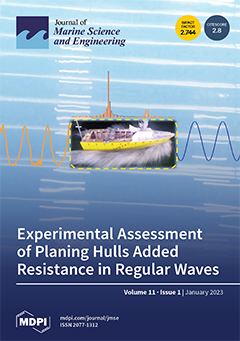J. Mar. Sci. Eng., Volume 11, Issue 1 (January 2023) – 233 articles
The proposed cover represents the essential elements of the study by means of four graphical elements: incoming wave profile (blue), C2s hull bow flare impact image, added resistance time series (orange), and an adimensional spectrum of both incoming wave and added resistance on top.
The bow flare impact of the planing hull represents the added resistance in waves, the main topic of the paper. The two timeseries represent the added resistance phase analysis results. The frequency-domain analysis used in the study and the presence of nonlinear effects such as the added resistance second harmonic content are shown in the spectra on top.
An image of regular waves generated in the Naples towing tank during the experiments fills the background. View this paper
- Issues are regarded as officially published after their release is announced to the table of contents alert mailing list.
- You may sign up for e-mail alerts to receive table of contents of newly released issues.
- PDF is the official format for papers published in both, html and pdf forms. To view the papers in pdf format, click on the "PDF Full-text" link, and use the free Adobe Reader to open them.





